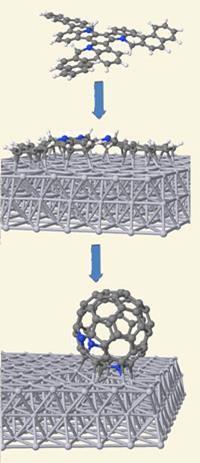Catalytic route to designer fullerenes cracked

Researchers in Spain have developed a highly efficient, surface-catalysed route to fullerenes. Unlike traditional methods, which lack synthetic control, the new approach allows heteroatoms to be installed at predetermined positions of the buckyball framework.
The Instituto de Ciencia de Materiales de Madrid (CSIC)-based team successfully synthesised both fullerene, C60, and triazafullerene, C57N3, with yields close to 100 per cent. Their technique not only allows controlled heterofullerene synthesis, but could also be adapted to make buckyballs that encapsulate small molecules.
’The advantage of this highly efficient process is that by starting with suitable precursors, heterofullerenes and other fullerene species can be obtained in a controlled way,’ says Berta Gomez-Lor, joint principal investigator. ’The "secret" is the use of a catalytic surface that is able to spontaneously induce dehydrogenation of the precursor molecule.’
Fullerene precursor molecules - with heteroatoms pre-installed - were deposited onto an activated platinum 111 surface by vacuum thermal evaporation. Heating to 750 K triggers complete fullerene formation, with the heteroatoms in their preselected positions.
’This is surely a potential route to hetero- and endohedral metallo-fullerenes’says Sho-ichi Iwamatsu of Nagoya University, prominent in the field of open-cage fullerene synthesis. ’However, key challenges remain regarding both bulk synthesis and the potential to practically encapsulate small molecules.’
Gomez-Lor acknowledges a limitation in the bulk quantity of material produced. However, initial results have shown that activated platinum nanopowder can be used as the catalyst, a significant step towards synthetic scale-up.
Endohedral fullerenes have potential in the field of drug and contrast agent delivery, but for this to be achieved, the process would have to be adapted to work at positive pressures.
’The controlled synthesis of fullerenes and heterofullerenes of specific structure in isolable quantities remains one of the great challenges still facing the synthetic organic chemist,’ says Lawrence Scott, a leader in the field of fullerene synthesis. ’I’m confident that such a goal is within reach, and this work represents another milestone along the road that will lead us there.’
Fred Campbell
Enjoy this story? Spread the word using the ’tools’ menu on the left.
References
et al. Nature454, 865 (DOI:10.1038/nature07193)






No comments yet